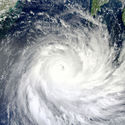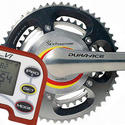In order to reduce methane emissions, we need to know where they come from. Methane, like other greenhouse gases, is invisible to human eyes – so how do we measure something we cannot see?
Human eyes can only see visual light, but sensors that use infrared light can see (detect) methane. Methane molecules absorb a particular frequency of light, so infrared sensors are ‘tuned’ to this frequency, rather like we tune a radio to find a particular station. Detecting methane molecules in the atmosphere is the first step. If we want to reduce methane emissions, we need to identify where the emissions are coming from and work on strategies to lower or even stop them from occurring.
MethaneSAT – a game changer in tracking emissions
Earth observation satellites are able to collect enormous amounts of information. Over the years, scientists have been using different satellites to track greenhouse gas emissions or to look closely at specific sites of interest. MethaneSAT combines the best of these satellite capabilities to more accurately do both jobs.
MethaneSAT has a wide field of view, covering 260 km – about the width of Te Waipounamu South Island. It travels at 7.5 km/second, orbiting the Earth every 100 minutes and covering the globe every 3–4 days. It is able to measure methane emissions virtually anywhere on Earth.
The satellite has a high resolution sensor so it can observe areas as small as 100 x 400 m – the footprint of a high school. And its measurements are precise. MethaneSAT can detect differences in methane levels as small as 2 parts per billion – as a comparison, that’s 2 seconds in 32 years!
MethaneSAT is like going from playing Minecraft to playing Legend of Zelda. We are going to have unprecedented spatial resolution, and we are going to be able to see all kinds of amazing details from the satellite images.
Dr Sara Mikaloff-Fletcher, NIWA scientist and role-playing game expert
MethaneSAT has another advantage – it is able to track the emissions back to their origins. These can be individual point sources such as gas pipeline leaks or large landfill sites. The satellite can also track cumulative emissions across larger areas such as wetlands or agricultural areas.
Gathering and interpreting the data
MethaneSAT’s Mission Operations Control Centre located at the University of Auckland is responsible for collecting and distributing the data. Radio transmitters on the satellite send the data to ground stations – satellite dishes that receive the signals. MethaneSAT connects with ground stations all around the world from as far north as Svalbard, near the North Pole, to Awarua, at the southern tip of the South Island.
The data is then sent to scientists at Harvard University and the Smithsonian Astrophysical Observatory in the United States. They’ve created an innovative data platform that quickly analyses the data and makes the information freely available to the public in a matter of days. This complex process previously took experts weeks or months to complete. Data from agricultural emissions is given to Aotearoa New Zealand’s MethaneSat research programme, where well-developed modelling frameworks have already been established.
Providing information quickly and free of charge enables industries, governments and concerned citizens to track emissions over time. This helps people make decisions and take action.
Making sure the data is accurate
Good decisions require good information. It’s very important that satellite data – and how it is interpreted – is as accurate as possible. Auckland University Professor David Noone and his team have been using special sensors to find the best frequency to pinpoint methane molecules in the atmosphere. Some of these sensors look up from the ground, and others are attached to airplanes and look down to Earth. Making the same measurements using different methods helps to refine the tracking technology the satellite uses and validate the data it collects.
Identifying the sources of methane is tricky. Once in the atmosphere, gases get mixed together, so people working with and modelling the data need to know about wind and other atmospheric conditions.
New Zealand offers a unique opportunity to inform methane measurements from agricultural and farming systems. The country is surrounded by oceans. Scientists are able to measure methane coming in to the country – it tends to be a uniform concentration because it’s mixed evenly in the atmosphere. When they measure the methane leaving the country, it tells them how much was produced. New Zealand has an excellent methane inventory – knowledge of where and how many livestock are farmed and wetland emissions. This information helps scientists, including NIWA’s Dr Sara Mikaloff-Fletcher and Beata Bukosa, to create accurate models that ‘untangle’ local emissions from those produced elsewhere.
This information will help inform action in Aotearoa and other countries and help to find solutions to optimise our farming and urban systems.
Nature of science
MethaneSAT detects methane concentrations in the atmosphere. New Zealand scientists are helping to fine tune modelling tools that infer or backtrack to where the emissions are released. This information is used by governments and/or industries to create policies or take steps to limit or reduce emissions. Science informs policy decisions rather than creating them.
Related content
Computer models are useful tools in scientific research. Ground truthing is the process of gathering data to test the accuracy of a model. The following resources explain how scientists collect and validate data used in models:
New Zealand scientists are looking for ways to reduce agricultural methane emissions. Read about plantain research and breeding low-methane sheep. Satellite data will help researchers find out if these approaches are successful in lowering emissions.
Visit our Methane – a potent greenhouse gas Pinterest collection for more resources.
Activity idea
Practise matching up satellite images with on-the-ground observations in the simple activity Validating remote sensing observations.
Useful links
Watch the TED talk The satellite helping slow climage change – right now. The video has a focus on action, hope and advocacy.
This short Environmental Defense Fund video demonstrates how MethaneSAT is bridging the gap to provide a single satellite with multiple tracking capabilities.
These videos use infrared cameras to highlight fugitive emissions escaping from oil and natural gas facilities:
- Invisible emissions – high tech cameras reveal methane leaks – United Nations
- Using an infrared camera to detect methane emissions at an oil and natural gas corporation facility – US Environmental Protection Agency
- Methane before and after – Environmental Defense Fund
Find out more in this RadioNZ Our Changing World programme An eye in the sky to detect methane emissions from December 2022.
Acknowledgement
This resource has been produced with funding from the Ministry of Business, Innovation and Employment and the support of the New Zealand Space Agency.





